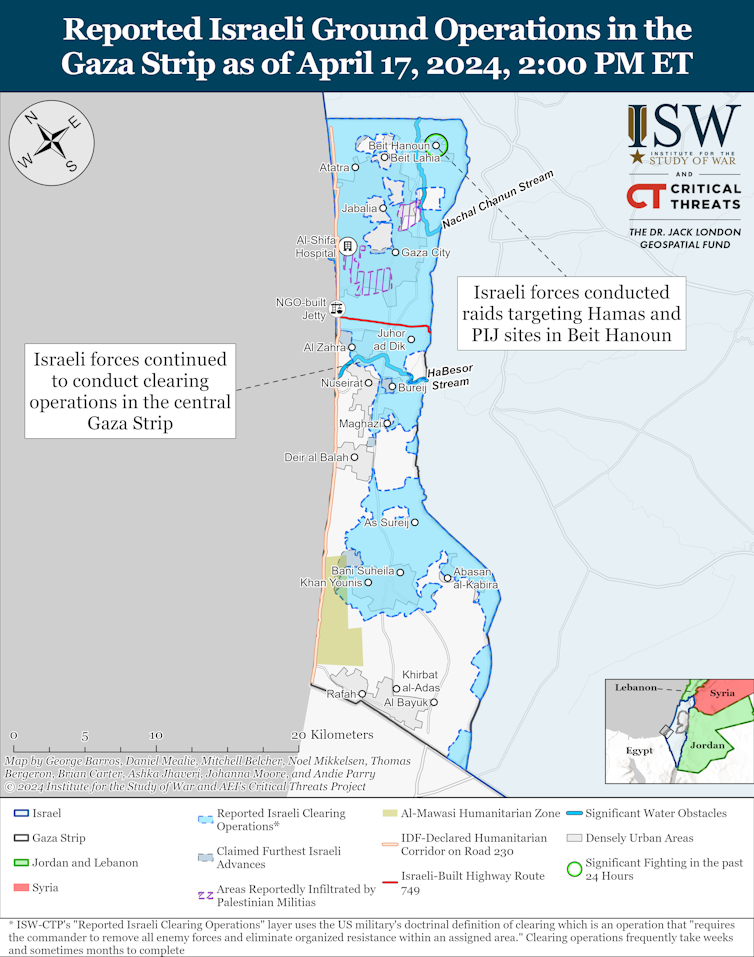| Per leggere l’articolo tradotto in italiano clicca l’icona blu google translate (la quarta da sinistra in fondo all’articolo) . Per un uso professionale e/o di studio raccomandiamo di fare riferimento al testo originale. |
Jonathan Este, The Conversation
The Israel Defense Forces (IDF) have reportedly been conducting operations in the Beit Hanoun area of the northern Gaza Strip conducting raids on Hamas and Islamic Jihad targets. The IDF says it has been working on information gleaned from questioning Palestinian fighters captured in the fighting.
According to a report in the Jerusalem Post on April 17, the Palestinian fighters were hiding out in schools in the area. A warning was issued to civilians to evacuate the buildings before the Israeli military moved in, the IDF said.
Meanwhile, ceasefire talks have been suspended as Israel reportedly prepares to move on Rafah, where more than a million Palestinians remain trapped. The Guardian reported this week that the IDF had confirmed buying 40,000 tents for evacuees.
Gaza Update is available as a fortnightly email newsletter. Click here to get our updates directly in your inbox.
When it comes to how the IDF identifies its targets, investigative journalists in Jerusalem have published reports recently delving into the use of artificial intelligence (AI) by Israel’s military and intelligence agencies in its conduct of the war. The investigation, by online Israeli magazines +927 and Local Call examined the use of an AI programme called “Lavender”. This examines a range of data to identify possible Hamas fighters. As Elke Schwarz, a reader in political theory at Queen Mary University of London, explains, this could include social network connections and family relationships.

Institute for the Study of War
Schwarz writes here: “The category of what constitutes relevant features of a target can be set as stringently or as loosely as is desired. In the case of Lavender, it seems one of the key equations was ‘male equals militant’.” Shades, she says, of the US doctrine during the drone wars of Barack Obama’s administration that apparently held that “all military-aged males are potential targets”.
Needless to say, the potential for misidentification is enormous. It’s important to note that the IDF is not the only military to be working with AI in this way. The US Department of Defense is known to be working on what it calls “Project Maven”, which – we’re told – allows the user to sign off on up to 80 targets an hour, apparently barking out the prompt to “accept, accept, accept”. As the 1970s Milgram experiments into obedience to authority suggested, controversially, humans – particularly men – will perform actions that are tantamount to torture if directed to with sufficient authority.
These are also not the first reports to emerge about Israel’s alleged use of AI to identify targets. Natasha Karner, a researcher into emerging technologies and global security at RMIT University in Australia, writes that the IDF was boasting of winning the first “AI war” in its’ intensive 11-day Operation Guardian of the Walls campaign in 2021.
But one function of the way the IDF is harnessing Lavender in this current conflict is its use alongside other systems. One called “Habsora” (or Gospel) tells the system that a building potentially houses a suspected fighter and another, apparently called “Where’s Daddy?”, reports on when the target returns to the building, which may or may not also contain the fighter’s family.
The Iranian dimension
Away from the charnel house that is the Gaza Strip, the focus has been on the aftermath of Israel’s strike on the Iranian embassy in Baghdad on April 1. The strike killed seven members of Iran’s Islamic Islamic Revolutionary Guard Corps, including General Mohammad Reza Zahedi, the Quds Force commander overseeing Syria and Lebanon.
According to Scott Lucas, an expert in Middle East conflicts at University
College Dublin, Israel has been assassinating Iran’s top military and intelligence brass for years. But what set the April 1 attack apart from the rest was that this was an attack on a diplomatic premises, ruled by international law to be “inviolable”. As is his wont, Iran’s supreme leader, Ayatollah Ali Khamenei, vowed revenge, declaring: “The Zionist regime will be punished by the hands of our brave men. We will make it regret this crime and others it has committed.”
Writing on April 11, Lucas kindly agreed to answer our questions on whether this would be likely to escalate into an all-out regional conflict. He felt that Khamenei’s rhetoric was very much performative. It was meant for both internal consumption, to rally a restless population suffering from a parlous economy crippled by sanctions and angry at the regime’s oppression, and to project strength in the region.
He speculated that Iran could launch an air assault, but this could undo Tehran’s diplomatic efforts over months to portray Iran as much of a victim as Gaza and to try to sow division between Israel and the US. And this was very much how it was to turn out when Iran’s drones and missiles flew last weekend.
